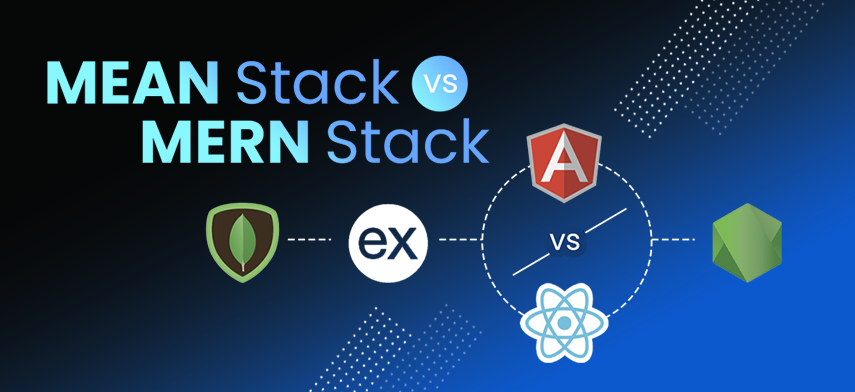In today’s digital age, where technological advancements and ever-changing market demands have taken center stage, choosing the right tech stack is highly challenging.
As a business owner, you may find it difficult when it comes to choosing the two widely used tech stacks - MEAN Stack and MERN Stack - that can successfully meet your project requirements and help you launch your digital products in the market.
In this blog, our experts have come up with an interesting MEAN Stack vs MERN Stack comparison that will help you make the correct decision for your project. So let’s get started.
MEAN Stack vs MERN Stack: Understanding the Basics
Both MEAN and MERN stack help businesses create superior web and mobile applications. MEAN stack technologies include MongoDB, Express JS, Angular, and Node JS. On the other hand, MERN stack technologies comprise MongoDB, Express JS, React, and Node JS. This implies that both stacks are similar and use the same technologies to deliver desired products and digital solutions.
The only difference between MEAN and MERN Stack is that they use a different tech component to satisfy front-end development requirements. The former uses Angular, whereas the latter uses React. Now, let us understand the key differences between these two terms.
MEAN Stack vs MERN Stack: Head-to-Head Comparison Between Angular and React
Now that we know the key differentiating factors between both stacks are Angular and React, our MERN stack vs MEAN stack discussion will completely focus on comparing both technologies on the basis of a few parameters.
| Parameters | Angular | React |
| Definition | Web application framework | JavaScript library |
| Written in | TypeScript | JavaScript |
| Foundation | Based on MVC | View in MVC; Flux for implementing architecture |
| Document Object Model (DOM) | Works with real DOM | Works with virtual DOM |
| Data Binding | Two-way data binding | One-way data binding |
| Language | JavaScript + HTML | JavaScript + JSX |
| Learning Curve | A decent amount of time is required to grasp the needed skills | It is easier to learn as compared to Angular |
| UI Rendering | Enables both server-side and client-side rendering | Enables both server-side and client-side rendering |
| Performance | Exhibits high-performance | Determines low performance due to virtual DOM |
| Dependency Injection | Fully supported | Not supported |
| Use Cases | Suitable for building interactive web apps | Suitable for building complex apps with recurring variable data |
| Abstraction | Medium | Strong |
| Testing & Debugging | Easily possible with a single tool | Set of tools are needed to perform different types of testing |
| Community Support | Large and continuously evolving | Large and continuously evolving |
This tabular comparison between Angular and React clearly highlights how a single technology component can majorly influence the overall MEAN stack vs MERN stack development scenario.
Let’s discuss these and many other significant parameters in more detail to understand the unique capabilities of both Angular and React, and end this MEAN vs MERN debate once and for all.
Popularity
According to the Stack Overflow Developer Survey 2022, React is the second most commonly used web technology by 44.31% of professional developers, while Angular is the first choice of 23.06 % of experts.
Stack share says that currently, 11K+ companies and 126K+ developers are using React on a regular basis. Whereas the number of companies and developers using Angular is more than 7K and 47K.
These stats are enough to conclude that both technologies are highly popular and are here to stay. You can easily hire dedicated developers of your choice and get started with software development right away.
Data Binding
You will get a more clear idea of the MERN vs MEAN stack differences if you have a good understanding of the data binding capabilities of Angular and React and how they work in particular.
Angular is backed by two-data binding, where the model state automatically changes with specific alterations in the interface elements. On the flip side, React uses one-way data binding, where you need to first update the model state in order to modify interface elements.
Moreover, when UI components are changed in React, your model state is bound to stay the same without having to deal with any kinds of changes.
Components
Angular consists of three main components namely Models, Views, and Controllers. It divides your code into individual components while helping you reuse the codebase and templates for your other project requirements. But when it comes to app structure, Angular lacks the needed flexibility.
On the contrary, React doesn’t represent a dedicated format to write code. It has an easily readable and well-optimized codebase in place to avoid interruptions. It exploits component trees to maintain the code logic. Besides, the use of functional programming successfully makes component declarations declarative.

UI Elements
The Angular framework supports an array of material design elements including pop-ups, layouts, and buttons. This network of elements enables your developers to fulfill simple and complex UI configuration requirements quickly and effectively.
However, to make the most out of the material design elements available in React, you need to first install Material-UI Library and Dependencies. This will expose your project to various free and paid UI elements that can help you build an engaging app interface.
DOM
Understanding the relationship of the document object model or DOM with Angular and React will surely take you one step closer to choosing the MEAN stack or MERN stack. Both Angular and React rely on DOM.
While Angular uses a real DOM, React uses a virtual DOM to reduce the costs of operations that demand making changes to what users view in their respective browsers. Put simply, they improve the process of re-rendering the view via DOM after an update.
A particular change performed in Angular results in updating the whole tree structure. Whereas, a virtual DOM helps React to modify a single component without affecting the entirety of the tree structure.
Development Tools
Angular and React both bring their own set of development tools and features to the table. With dependency on a state management library, React plays a vital role in optimizing routing, state management, and API interaction.
Angular, on the other hand, doesn’t rely on external libraries. It has built-in functionalities like component-based routing and project building. However, you can easily extend its features by using state management frameworks like NgRx and RxJS.
Performance
React offers a stable and performant runtime environment as its virtual DOM trees are lightweight and built on the server. It represents a unidirectional data flow structure that reduces the workload while increasing the processing power.
When it comes to performance, Angular behaves differently. It is driven by a bidirectional data flow structure, where monitoring changes are mandatory and continuous (for all watchers and their values). This process indirectly harms the overall performance of Angular. But you can easily reduce its impact with Angular Ivy renderer.
Component Architecture
Our discussion of choosing the correct one between MERN and MEAN would be incomplete without understanding the component architecture of React and Angular. Both are component-based with contemporary and reusable elements in place.
However, there’s a huge difference in their language usage. While React uses JavaScript, Angular exploits TypeScript to create a progressive and bug-free web development environment.
Language
As Angular is driven by TypeScript, developers get enough room to find typos in a hassle-free way. It also makes it easier for them to navigate through the code. But that’s not the case with React.
React can be written in JavaScript ES6+ with the help of JSX, which makes it appear just like HTML. It can successfully enhance and compile JSX code in a browser via a transcompiler like Babel. Additionally, React can use TypeScript. But it lacks the native support for the same.
Developer Productivity
Angular is a fully functional framework to work with. It offers a command-line interface (CLI) that amplifies developer productivity by 2X. Besides, there is no need to integrate third-party tools to achieve advanced functionalities.
Contrarily, React is just a library that needs third-party support for minute feature additions. It demands more effort from your developers’ end, thereby affecting their productivity.
Testing
You should never forget to discuss the testing capabilities of Angular and React while comparing the MEAN stack with the MERN stack. You can easily test an application written in Angular by using a single tool such as Jasmine.
However, to test apps built with React, you need to have a set of tools in place. While the JavaScript code can be easily tested with Jest, Enzyme can help you test the necessary elements.
Use Cases
You are limited here by the choice of the framework. All types of apps can be built with both MEAN and MERN stack.
MEAN stack vs MERN Stack: Which One to Choose?
Comparing MEAN stack vs MERN stack and choosing the right one between them totally depends on what your project requirements are. Because both are the same but bring their own set of advantages to the table with a different technology in place.
MEAN tech stack consists of Angular that offers seamless browser compatibility, built-in testing features, custom components, and more. Whereas the MERN tech stack uses React to provide high performance, declarative user interface, complex update handling capabilities, and so on.
While making the correct choice can help your project thrive, underestimating its importance can negatively impact the entire software development life cycle. As such, you need to decide which technology stack perfectly fits your business requirements and complements your vision. If you are still contemplating or unable to pick the ideal one, you can outsource your requirements to Mobisoft and start your project right away!





 January 9, 2023
January 9, 2023


